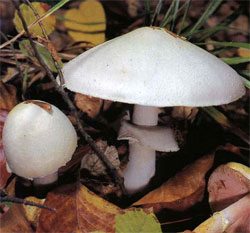Field mushroom (Agaricus arvensis)
- Division: Basidiomycota (Basidiomycetes)
- Subdivision: Agaricomycotina (Agaricomycetes)
- Class: Agaricomycetes (Agaricomycetes)
- Subclass: Agaricomycetidae (Agaricomycetes)
- Order: Agaricales (Agaric or Lamellar)
- Family: Agaricaceae (Champignon)
- Genus: Agaricus (champignon)
- Type: Agaricus arvensis (Field champignon)
 fruiting body:
fruiting body:
Hat with a diameter of 5 to 15 cm, white, silky-shiny, hemispherical for a long time, closed, then prostrate, drooping in old age. The plates are curved, white-grayish in youth, then pink and, finally, chocolate-brown, free. The spore powder is purple-brown. The leg is thick, strong, white, with a two-layer hanging ring, its lower part is torn in a radial manner. It is especially easy to distinguish this mushroom during the period when the cover has not yet moved away from the edge of the cap. The flesh is white, turning yellow when cut, with the smell of anise.
Season and location:
In summer and autumn, field champignon grows on lawns and glades, in gardens, near hedges. In the forest, there are related mushrooms with the smell of anise and yellowing flesh.
It is widely distributed and grows abundantly on the soil, mainly in open spaces overgrown with grass – in meadows, forest clearings, along roadsides, in clearings, in gardens and parks, less often in pastures. It is found both in the plains and in the mountains. Fruiting bodies appear singly, in groups or in large groups; often form arcs and rings. Often grows next to nettles. Rare near trees; spruces are an exception. Distributed throughout Our Country. Common in the northern temperate zone.
Season: from late May to mid-October-November.
The similarity:
A significant part of the poisoning occurs as a result of the fact that field mushrooms are confused with white fly agaric. Particular care must be taken with young specimens, in which the plates have not yet turned pink and brown. It looks like sheep and poisonous red mushroom, as it is found in the same places.
Poisonous Yellow-skinned Champignon (Agaricus xanthodermus) is a smaller species of champignon that is often found, especially in plantings of white locust, from July to October. It has an unpleasant (“pharmacy”) smell of carbolic acid. When broken, especially along the edge of the cap and at the base of the stem, its flesh quickly turns yellow.
It is similar to many other types of champignons (Agaricus silvicola, Agaricus campestris, Agaricus osecanus, etc.), differing mainly in larger sizes. The crooked mushroom (Agaricus abruptibulbus) is most similar to it, which, however, grows in spruce forests, and not in open and bright places.
Evaluation:
Note:









